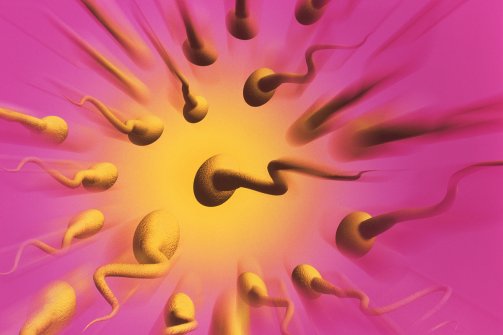Sacre bleu!
Or is it ‘sacre blanc’? French sperm counts are apparently falling quicker than Napoleon’s soiled trousers at the Battle of Waterloo. Is it all that garlic and onions? Apparently not according to semen scientists. Other dark forces are at play in our underpants.
What’s happening to modern testicles in the developed world? It’s scary. If this was a women’s health issue they’d be protests and government emquiries and panicked action taken, but our ballbags don’t get any such political protection at all!
Forget the econimic crisis, France needs to act now or face scrotal destruction!
Semen Simon
In recent decades, says a report, French sperm counts have
plunged, and environmental factors may be the culprit, writes Tracy McNicoll.
An astounding new study in the British medical journal Human Reproduction this week has revealed that French sperm counts plunged by a third between 1989 and 2005, 32.2 percent or about 1.9 percent annually. The British press might have declared the results “a blow to the bedroom reputation of French men” or headlined on “Gallic sperm,” calling to mind armies of the embattled swimmers donning Asterix-style winged caps. The Daily Mail even trumpeted, “Male Fertility Falls in France. Will UK Be Next?” But the findings of one of the largest sperm quality probes ever should, in fact, raise the alarm far and wide.
The study led by researchers from France’s Institute for Health Surveillance explored semen-sample data for 26,609 partners of totally infertile women from 126 assisted reproductive technology (ART) centers all over France for more than 17 years. The results project that for an average 35-year-old man, sperm concentration dropped from 73.6 million per milliliter in January 1989 to 49.9 million/ml in December 2005. Those values are still well above the commonly referenced threshold for infertility (15 million/ml). But 55 million/ml is considered the benchmark below which sperm concentration can impact the time it takes to conceive. On another indicator of sperm quality, the percentage with a shape deemed normal, the study found a “significant” decrease of 33.4 percent over the same period.
The nationwide long-term study—remarkable for its exceptional scope and approach—joins a scientific literature fueling concerns that environmental and lifestyle factors are putting fertility at risk. “This constitutes a serious public health warning,” the study team writes. “The link with the environment particularly needs to be determined.” Although their report doesn’t aim to pinpoint a cause, the French researchers note the growing evidence that exposure, especially in the womb, to endocrine disruptors—widespread chemical substances found in some plastics, like the hotly debated additive Bisphenol A, pesticides, and other everyday sources that can alter hormonal balances—can act to impair reproduction.

Joëlle Le Moal, one of the lead authors of the report, says there is no reason to think French men’s sperm is inferior to anyone else’s. “The particularity of our study is that it is the first conducted on a country-wide level,” she tells The Daily Beast in Paris. “If we did the same type of study in other countries, it is certainly very likely that we’d see the same sort of trend.” But, she nuances, previous studies have shown marked geographical differences in measured sperm quality, between countries or even within countries. Wide gaps have been detected between Denmark and Finland, for example. And a 1995 study of Paris-area donors between 1973 to 1992 showed a 2.1 percent annual drop in sperm concentrations, while another of donors in Toulouse, in France’s southwest, over a similar period showed no decline. Indeed, a history of mixed evidence has left open the debate on global trends in sperm quality.What made the new and, um, seminal study possible—and perhaps uniquely so—was France’s so-called Fivnat database, a professional association’s register of most of France’s assisted fertilization attempts from the 80s until 2005. “This register is extremely precious and I’m not sure a register of the sort exists anywhere else in the world,” says Dr. Le Moal. “We were really lucky.” Like any material from an older database, she says, it wasn’t perfect, but it fit the job.
From the 440,000 recorded ART attempts involving men aged 18 to 70, the researchers selected data from more than 26,000 men whose partners had absent or blocked Fallopian tubes. Selecting men with indisputably infertile partners staved off one of many known and problematic biases in studies on sperm quality: that donors are often selected precisely for their fertility. “For infertile partners where the woman is later determined to be totally sterile, there is no reason for the partner to have different semen quality than the population average,” the study’s authors write. Studies, meanwhile, that try to select subjects at random—Nordic countries, for instance, request samples from armed forces personnel—risk a different bias due to low response rates from potential volunteers.
The French data also skirts some bias in comparable data elsewhere because of France’s famously generous welfare state. The sampled fertility treatments have historically been fully covered by social security.
Nevertheless, the researchers admit their study is still susceptible to a socio-economic skew. Despite treatments widely accessible to French couples, studies show the ones who actually use them are likely to be more educated. As it happens, during the study’s timeframe, more educated men were more likely to cut back on smoking and less likely to put on weight, two socio-economic factors that tend to influence sperm quality. In short, the scientists argue, their findings could actually underestimate the problem. It might be even worse.
Source: http://www.thedailybeast.com/articles/2012/12/08/sperm-count-plummets-for-french-men-new-study.html




